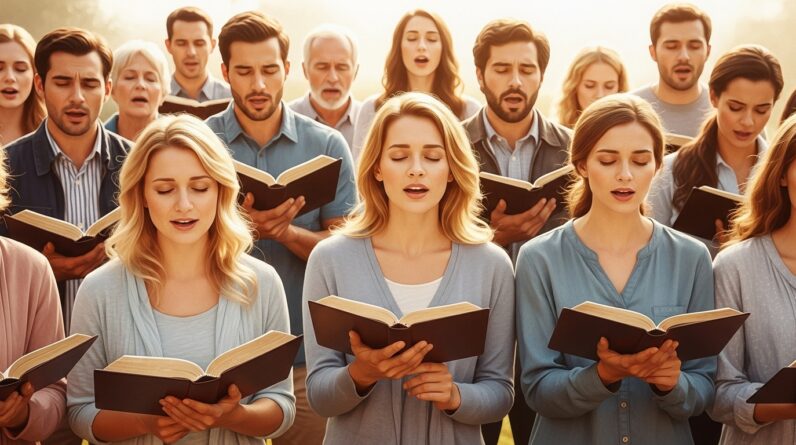Imagine a world without music. It’s difficult, right? Music has been an integral part of human culture since ancient times, and it holds a special place in the realm of worship. In this article, we will explore the fascinating evolution of worship music, as inspired by three powerful verses from the Bible: Psalm 104:33, Psalm 147:1, and Psalm 150:6. From the humble beginnings of simple melodies to the exuberant choruses that resonate in churches today, join us as we uncover the journey of worship music and its transformative power.
Pre-Biblical Origins of Worship Music
Ancient Mesopotamian Worship
The origins of worship music can be traced back to ancient Mesopotamia, one of the cradles of civilization. Mesopotamian worship involved the chanting and singing of hymns to honor their gods and goddesses. These hymns were often accompanied by various musical instruments such as drums, harps, and flutes. The Mesopotamians believed that through their worship music, they could communicate with the divine and seek blessings for their communities.
Egyptian Hymns
Egyptian civilization also had a rich tradition of worship music. The Egyptians believed in the power of music to invoke the presence of their gods and goddesses. Hymns were sung during temple rituals and ceremonies, praising the deities for their blessings. The Egyptians used a variety of instruments, including the sistrum, a type of rattle, and the harp, to accompany their hymns. These hymns were often performed by priests and priestesses who were trained in the art of worship music.
Greek and Roman Chants
The ancient Greeks and Romans also had their own forms of worship music. In both cultures, worship was an integral part of religious practices. Chants and songs were performed during religious ceremonies and festivals to honor their gods and goddesses. These chants were often sung by choirs and accompanied by instruments such as lyres, a stringed instrument similar to a small harp. The Greeks and Romans believed that worship music had the power to bring them closer to the divine and to create a sense of unity within their communities.
The Early Development of Worship Songs in the Bible
David’s Praise in the Psalms
In the Bible, the Book of Psalms showcases the early development of worship music. Many of the psalms were written by King David, who was known for his musical abilities. David used music as a form of praise and expression of his deep love for God. Psalm 104:33 says, “I will sing to the LORD all my life; I will sing praise to my God as long as I live.” Through his psalms, David set a precedent for the use of music in worship and demonstrated the intimate connection between music and devotion.
Inclusion of Instruments in Worship
As worship music evolved in biblical times, the use of musical instruments became more prevalent. In the Old Testament, various instruments were mentioned as being used in worship, such as harps, lyres, trumpets, and cymbals. These instruments were played alongside the singing of psalms and hymns, adding a new dimension to the worship experience. The combination of voices and instruments created a harmonious and joyful atmosphere that uplifted the spirits of those who participated in worship.
The Influence of Solomon’s Temple
Solomon’s Temple, also known as the First Temple, played a significant role in the development of worship songs in the Bible. Built in Jerusalem by King Solomon, the temple became the central place of worship for the Israelites. It was adorned with instruments and had dedicated choirs and musicians who led the congregation in worship. The grandeur and sacredness of the temple inspired a sense of awe and reverence during worship, amplifying the impact of the music being performed.

The Transition from Verse to Chorus
The Rise of Temple Worship
During the time of Jesus and the early Christian church, worship evolved further, moving from individual verses to collective participation. The Temple in Jerusalem continued to be a vital center for worship, but it became increasingly important for the entire congregation to engage in praise and worship together. This shift marked a transition from music performed solely by priests and trained musicians to a more inclusive and participatory worship experience.
Collective Participation in Praise
As Christianity spread, so did the practice of collective participation in praise and worship. The apostle Paul encouraged believers to “sing psalms and hymns and spiritual songs among yourselves, and make music to the Lord in your hearts” (Ephesians 5:19). This emphasis on communal singing and music-making fostered a sense of unity and fellowship among believers. The act of joining together in worship through song created a shared experience that strengthened the bonds of the early Christian community.
Increasing Use of Repetition
Another significant change during this period was the increasing use of repetition in worship music. Repetition of melodies, lyrics, and musical phrases allowed the congregation to fully engage with the music and internalize the message being conveyed. Repetition also helped to create a sense of familiarity and continuity in worship, allowing individuals to connect more deeply with the songs and the spiritual truths they expressed. This use of repetition laid the foundation for the development of choruses in worship music.
The Role of the Psalms in Worship Music
The Diversity of Psalms
The Book of Psalms contains a wide range of songs and poems that cover various themes and emotions. Some psalms express praise and thanksgiving, while others convey lament, confession, or supplication. The diversity of the psalms provides a rich tapestry of worship music that resonates with the myriad experiences and emotions of believers. The inclusion of these different types of psalms in worship allows individuals to express their hearts fully and find solace, encouragement, and inspiration in their relationship with God.
Expressing Emotions and Communal Identity
The psalms not only serve as vehicles for expressing individual emotions but also contribute to the formation of communal identity. Through the shared recitation or singing of psalms, believers come together in a collective expression of worship and faith. The psalms provide a shared language that unites believers across time and place, creating a sense of continuity and connection with the wider body of Christ. This communal aspect of psalmody enhances the worship experience and promotes a spirit of unity and belonging.
The Psalms as a Foundation for Worship Music
The Psalms have profoundly influenced worship music throughout history. Their poetic and lyrical nature has inspired countless composers, hymn writers, and songwriters to set their words to music. From classical compositions to contemporary worship songs, the Psalms continue to be a rich source of inspiration and material for worship music. Their timeless themes and deep spiritual insights make them relevant in any era or cultural context, reminding believers of the enduring power and beauty of worship music rooted in the Word of God.

The Impact of the Reformation on Worship Music
Translation of Psalms into Vernacular Languages
The Protestant Reformation in the 16th century brought about significant changes in worship practices, including a renewed emphasis on the participation of the congregation. One of the key aspects of the Reformation was the translation of the Bible, including the Psalms, into vernacular languages. This allowed ordinary believers to have direct access to the Scriptures and participate more fully in worship. The availability of vernacular translations also paved the way for the incorporation of psalms and hymns in the language of the people, enabling them to engage more deeply with the music and its message.
Congregational Singing in the Protestant Church
The Reformation also emphasized the importance of congregational singing in the Protestant church. Martin Luther, a key figure in the Reformation, recognized the transformative power of music in worship and sought to involve the congregation actively. He composed hymns in the vernacular language, based on biblical texts, and encouraged believers to sing together as an integral part of their worship experience. Congregational singing became a hallmark of the Protestant tradition, providing a means for believers to express their faith, share communal worship, and engage with the Word of God.
The Birth of Hymnals
With the rise of congregational singing, the need for organized collections of hymns became apparent. Hymnals started to emerge, containing a selection of hymns and psalms for use in public worship. These hymnals served as a guide for congregational singing and helped to standardize the repertoire of worship music. Hymnals also played a role in the transmission and preservation of traditional hymns, ensuring their continuity across generations. They became an essential tool for the Protestant church, enabling believers to participate actively and contribute to the worship experience.
The Influence of Hymns on Chorus-based Worship
The Emergence of Choruses in Hymnals
As hymnals became more widely used, new forms of worship music began to emerge. Alongside traditional hymns, shorter songs with repetitive choruses started to appear in hymnals. These choruses provided a concise and memorable way for the congregation to engage in worship. With their catchy melodies and simple lyrics, choruses quickly gained popularity and became a staple of worship music in many traditions. They allowed for greater congregational participation and encouraged a more dynamic and interactive worship experience.
Integration of Hymns into Church Services
Hymns played an integral role in traditional church services, with congregations singing hymns at various points during the worship service. Hymns often accompanied key moments such as the opening of the service, the response to the sermon, and the closing benediction. This intentional integration of hymns into the fabric of the worship service helped to create a cohesive and meaningful worship experience. Hymns provided a collective voice for the congregation to express their faith, gratitude, and devotion to God.
Exploration of New Musical Styles
In recent decades, there has been a growing exploration of new musical styles within the context of worship music. This shift has been driven by a desire to connect with a wider range of worshipers and to reflect the diversity of musical tastes and cultural backgrounds within the Church. Worship music now encompasses a broad spectrum of genres, including contemporary Christian, gospel, rock, pop, and even rap. This willingness to embrace new musical styles has allowed worship music to evolve and adapt to the changing cultural landscape, ensuring its continued relevance and impact.

Contemporary Worship: The Era of Praise and Worship Music
The Rise of Contemporary Christian Music
In the late 20th century, a new era of worship music emerged with the rise of contemporary Christian music. Contemporary Christian music, often referred to as CCM, encompasses a wide range of musical styles and genres that are specifically crafted for worship settings. Contemporary worship songs emphasize a personal and intimate connection with God, often expressing themes of praise, adoration, and surrender. The popularity of CCM has increased the accessibility and diversity of worship music, appealing to a broader audience and enabling believers to engage with God in a fresh and modern way.
Evolution of Worship Bands and Artists
Contemporary worship music has also given rise to the formation of worship bands and artists who specialize in creating and performing worship songs. These bands and artists lead worship at churches, conferences, and events, providing a platform for believers to encounter God through music. Worship bands often consist of vocalists, guitarists, keyboard players, drummers, and other musicians, creating a dynamic and engaging musical experience. This shift towards professional worship leaders has elevated the quality and creativity of worship music, enhancing the overall worship experience for congregations.
Transition to Modern Worship Services
Contemporary worship music has not only transformed the music itself but has also shaped the overall structure and format of worship services. Modern worship services often incorporate extended times of praise and worship, with a focus on creating an immersive and participatory worship experience. These services may feature a combination of traditional hymns, contemporary worship songs, and instrumental music. In addition to music, modern worship services often include multimedia elements, such as visual presentations, video clips, and interactive elements, to enhance the overall worship experience and engage all the senses.
The Power and Purpose of Worship Music
Connecting with the Divine
Worship music serves as a powerful tool for believers to connect with the divine. Through the melodies, lyrics, and rhythms of worship songs, individuals can express their love, gratitude, and awe towards God. Music has the unique ability to transcend language and cultural barriers, allowing people from diverse backgrounds to come together in worship. Whether it is through singing, playing an instrument, or simply listening, worship music provides a means for believers to enter into God’s presence, experience His love, and respond in heartfelt worship.
Facilitating Corporate Worship
Worship music plays a crucial role in facilitating corporate worship. As believers join together to sing and praise, a sense of unity and shared purpose is fostered. Worship music creates a space where individuals can lay aside their distractions and concerns, and focus their hearts and minds on God. The collective singing of worship songs strengthens the bonds of community, as believers encourage and uplift one another through their shared expression of worship. Worship music provides a framework for believers to engage in corporate worship, fostering an atmosphere of reverence, joy, and intimacy with God.
Promoting Spiritual Growth and Encouragement
Beyond the act of worship itself, worship music has the power to promote spiritual growth and encouragement. The lyrics of worship songs often contain biblical truths and promises, reminding believers of God’s faithfulness and love. Through repetitive choruses and memorable melodies, these truths are internalized and become a source of strength and hope. Worship music can inspire, comfort, and challenge believers to live out their faith in practical ways. It can also serve as a source of healing and restoration, offering solace to those who are going through difficult seasons in life.

Cultural Adaptation and Global Influence of Worship Music
Worship Music in Different Cultural Contexts
Worship music has the remarkable ability to adapt and resonate within different cultural contexts. As the gospel has spread to various parts of the world, local cultures have embraced worship music and incorporated their own unique musical styles, instruments, and languages. This cultural adaptation has resulted in a rich tapestry of worship music, with each culture bringing its own distinct flavor to the global worship community. From African rhythms to Latin American melodies, worship music reflects the diversity and creativity of God’s people across the globe.
Cross-cultural Exchange and Adoption
The globalization of worship music has also led to cross-cultural exchange and the adoption of songs and styles from different traditions. Contemporary worship songs, hymns, and choruses from one culture are often translated and performed in another, creating connections and shared experiences among believers from different backgrounds. This cross-cultural exchange not only enriches the musical repertoire of worship but also fosters a sense of unity and appreciation for the global body of Christ. Through shared worship experiences, believers can learn from and celebrate the cultural expressions of worship that exist beyond their own familiar traditions.
Impact of Globalization on Worship Music
In the age of globalization, advancements in technology and communication have significantly impacted the production, distribution, and consumption of worship music. With the advent of digital platforms and streaming services, worship music has become more accessible and widespread than ever before. Believers can now access a vast library of worship songs and resources from around the world, enabling them to engage in worship wherever they are. Globalization has also facilitated collaborations between worship bands, songwriters, and artists across borders, resulting in a greater diversity and fusion of musical styles in worship music.
Future Trends in Worship Music
Innovation in Musical Styles and Genres
Looking to the future, we can expect further innovation in musical styles and genres within worship music. As technology continues to advance, new possibilities for sound production and music creation arise. Worship music may incorporate elements of electronic music, experimental sounds, and emerging genres, appealing to a younger generation of worshipers. This innovation in musical styles and genres will continue to push the boundaries of worship music, creating dynamic and engaging worship experiences for believers.
Integration of Technology in Worship
Technology will undoubtedly play an increasingly important role in worship music moving forward. As churches embrace digital platforms, live streaming, and virtual communities, worship music will have to adapt and utilize technology to reach congregations both in-person and remotely. Visual elements, such as immersive projections and virtual reality, may be integrated into worship services to enhance the visual experience and create a more engaging worship environment. The integration of technology will enable worship music to transcend physical limitations and provide meaningful worship experiences for believers in diverse settings.
Continued Emphasis on Congregational Participation
Despite the advancements in technology and changes in musical styles, the emphasis on congregational participation in worship music will remain steadfast. The power of collective worship, where believers join their voices together in unity, cannot be replicated by any technological gadget or performance. Congregational singing, whether it’s through traditional hymns, contemporary worship songs, or choruses, will continue to be the heartbeat of worship music. The future of worship music will strive to create spaces where every believer can actively participate and experience the transformative power of worship.









